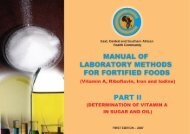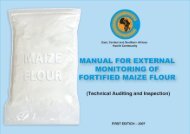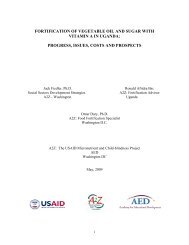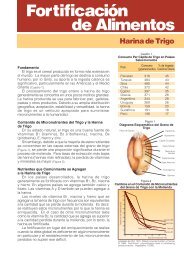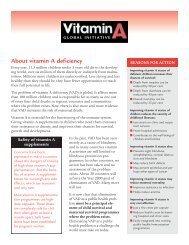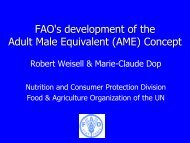manual of methods for determining micronutrients in fortified foods
manual of methods for determining micronutrients in fortified foods
manual of methods for determining micronutrients in fortified foods
You also want an ePaper? Increase the reach of your titles
YUMPU automatically turns print PDFs into web optimized ePapers that Google loves.
1. Inoculate Enterococcushirae ATCC 8043 <strong>in</strong> 1 mLTrypticase soy broth. Incubate 24 hours at 35-<br />
37°C.<br />
2. Add 1 mL glycer<strong>in</strong>e-15% and store at -70°C.<br />
3. Repeat this procedure dur<strong>in</strong>g preservation <strong>of</strong> the culture <strong>in</strong> Trypticase soy broth with glycerol-15%<br />
from the transference <strong>of</strong> the stra<strong>in</strong>.<br />
D. Inoculum preparation<br />
1. Transfer cells from the stock culture <strong>of</strong> Enterococcushirae ATCC 8043 to sterile tube conta<strong>in</strong><strong>in</strong>g 10<br />
mL broth <strong>for</strong> <strong>in</strong>oculum (HiMedia 133).<br />
2. Incubate 16-18 h at 35-37 °C.<br />
3. Under aseptic conditions, centrifuge culture at 3,000 rpm <strong>for</strong> 5 m<strong>in</strong>utes and decant the supernatant.<br />
Wash cells with 10 mL sterile 0.9% sal<strong>in</strong>e solution, resuspend<strong>in</strong>g the cells <strong>in</strong> the pellet by agitation.<br />
Repeat this procedure two times more and resuspend the pellet <strong>in</strong> 10 mL sterile 0.9 % sal<strong>in</strong>e solution.<br />
This suspension is the stock <strong>in</strong>oculum.<br />
a) Appearance <strong>of</strong> the <strong>in</strong>oculum after centrifugation <strong>for</strong> the first time. Bacteria cells <strong>for</strong>m a pellet at the bottom<br />
<strong>of</strong> the tube. b) After elim<strong>in</strong>at<strong>in</strong>g the media and resuspend<strong>in</strong>g the pellet <strong>in</strong> isotonic sal<strong>in</strong>e solution, the liquid <strong>in</strong><br />
the tube looks turbid. c) The washed cells <strong>for</strong>m a pellet at the bottom <strong>of</strong> the tube after the f<strong>in</strong>al centrifugation.<br />
4. To obta<strong>in</strong> the work <strong>in</strong>oculum, take 10 µL <strong>of</strong> the stock <strong>in</strong>oculum and add it to 10 mL sterile isotonic<br />
sal<strong>in</strong>e solution.<br />
5. A larger quantity <strong>of</strong> <strong>in</strong>oculum might be prepared follow<strong>in</strong>g the proportion <strong>of</strong> stock <strong>in</strong>oculum/isotonic<br />
sal<strong>in</strong>e solution. Store it <strong>in</strong> 5-mL sterile vials.<br />
6. Label the vials with the medium name, lot number and expiration date, and store <strong>in</strong> the refrigerator.<br />
7. Use the amount <strong>of</strong> <strong>in</strong>oculum needed at room temperature the day <strong>of</strong> the analysis.<br />
- 56 -






